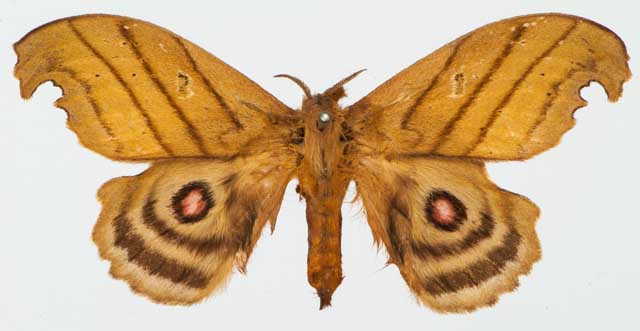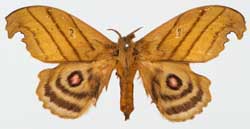Hyperchiria plicata
|
|
Updated as per Lemaire's Hemileucinae 2002, January 15, 2008
Updated as per personal communication with Christian Kutzscher (male: 57mm; Brazil); April 8, 2014
Updated as per personal communication with Augusto Rosa, April 16, 2021
|
Hyperchiria plicata
(Herrich-Schaeffer, [1855])
Automeris plicata

Hyperchiria plicata male, Itamonte, Minas Gerais, Brazil,
January 10, 2021, courtesy of Augusta Rosa.

Hyperchiria plicata male, Brazil, courtesy of Christian Kutzscher,
from SDEI - Senckenberg Deutsches Entomologisches Institut Collection
TAXONOMY:
Superfamily: Bombycoidea, Latreille, 1802
Family: Saturniidae, Boisduval, [1837] 1834
Subfamily: Hemileucinae, Grote & Robinson, 1866
Tribe: Hemileucinae, Grote & Robinson, 1866
Genus: Hyperchiria, Hubner, [1819]
|
DISTRIBUTION:
Hyperchiria plicata
(wingspan: males: 56-59mm; females: 70-72mm / forewing length:
males: 27-29mm; females: 35-37mm) flies in
southeastern Brazil: Espirito Santo; Rio de Janeiro; Minas Gerais: Itamonte (AR).
This species lacks black rings on the upperside of the abdomen. The forewing is elongate with a produced yet truncated apex.
The outer margin is very concave under the very strong subapical tooth. The dark antemedian, median, postmedian and subterminal
lines are all straight, thin and parallel.
FLIGHT TIMES AND PREFERRED FOOD PLANTS: There probably at least two generations annually with peak flights in January-February and July.
Hyperchiria plicata larvae probably eat Berberis lauina, Cassia corymbosa, Celtis spinosa, Fagus, Ficus benjamina, Laburnum,
Platanus orientalis, Quercus, Quercus ilex and Serjania.
Visit the Hyperchiria plicata Group to see a comparison plate covering the eight species listed by
Brechlin and Meister, 2013, as belonging to the Hyperchiria plicata Group, which has species where the iris of the hindwing ocellus is red with a relatively
small white pupil, and the hindwing ground colour is beige.
ECLOSION, SCENTING AND MATING:
Males use well-developed antennae to seek out females which scent at night. Females are active from 10:00 pm until midnight; males are active from 10:30 pm
until 1:00 am.

Hyperchiria plicata female, Rio de Janeiro, Brazil,
on my home computer only.
EGGS, LARVAE, COCOONS AND PUPAE:
Typical of species in the Genus Hyperchiria and the
Subfamily Hemileucinae, the larvae are armed with urticating spines. |
|
Larval Food Plants
It is hoped that this alphabetical listing followed by the common name of the foodplant will prove useful. The list is not exhaustive.
Experimenting with closely related foodplants is worthwhile.
Berberis lauina
Cassia corymbosa .......
Celtis spinosa
Fagus
Ficus benjamina
Laburnum
Platanus orientalis
Quercus
Quercus ilex
Serjania
|
Barberry
Autumn senna
Hackberry
Beech
Benjamin tree
Bean tree
Oriental sycamore
Oak
Holly/Holm oak
Serjania
|
Return to Hyperchiria genus
Return to Main Saturniidae Index






